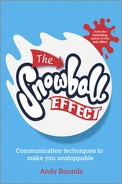31
When you want to ensure everyone – including you – thinks you’re great
To enjoy your job more, there’s a question you absolutely must have a good answer to: “What do you do?” So how would you complete the sentence . . .
My job is to . . .
Most people answer this question with either:
- What they are – “I’m an accountant”; or
- What they do – “I prepare tax returns”.
Neither grabs you, do they? And that’s because people are much more interested in:
- What they cause – “I help people pay less tax”.
Doesn’t this person sound useful?! And I bet they enjoy their job too. They’ll know the value they deliver to others. They’ll be in demand. They’ll probably be very successful. By sorting out their inside (how they feel about themselves), they now have a valuable outside (how others see them).
Weird, isn’t it? It’s the same accountant. They’re just describing themselves more effectively now. Here’s how you can do the same.
An “Elevator Pitch” can focus on one of three things:

The right-hand side is by far the most valuable. So, you should talk about that side more.
How to ensure you think you’re great
Once you know to focus on the AFTERs you cause, you see examples of it everywhere:
- Disney talks about “making your dreams come true”, not its cartoons.
- Kodak talks about your memories, not its photographs.
- Graham Gooch calls himself the England cricket team’s “Run-making Coach”, not “Batting Coach”.
- And, for me, my job is to help people communicate better, not to be a consultant/author.
To create an AFTERs-rich Elevator Pitch, there are three elements:
Here are three examples, to show how the steps work.

So, what’s your Elevator Pitch?

Compare this to your Elevator Pitch at the start of this chapter. Can you see how much more valuable you look now? Even though, just like the accountant above, you’re still the same person.
Once you have an impressive AFTERs-rich Elevator Pitch, your next step is to find evidence that proves to you that it’s right. For instance, think you’re a Tax Reducer? Then identify:
- Examples of when you’ve saved people tax.
- The total amount of tax you’ve saved.
- Tax advice that others don’t know.
And then work hard to get even better at delivering your AFTERs. For instance:
- Find new ways to increase tax savings.
- Give free advice about it.
- Keep at the forefront of your industry.
- Ask others for their tax-saving ideas.
- Publish white papers about saving tax.
. . . anything that keeps you as AFTERs-y as possible.
And, of course, AFTERs are also a great way to align your team with your vision. For example, Bev James, CEO of The Coaching Academy (the world’s largest training school for coaches), told me that she uses AFTERs to remind her team why they do what they do. So, they no longer think of themselves as “coaches”; instead, they “help people achieve more than they thought they could”. Imagine the power of having your whole team thinking like that.
How to ensure everyone thinks you’re great
When I want to pay less tax, I’ll go to someone who sees their role as a Tax Reducer, not as an Accountant.
When I want to grow my business, I’ll go to a bank which talks about my Business Growth, not its Business Development Loans.
When I want to score more runs, I’ll go to Graham Gooch, not to a batting coach (though even he might struggle to help someone who’s blind in one eye).
In other words, once you’ve convinced yourself of the AFTERs you cause, it’s relatively easy to convince others. You just need to mention your AFTERs every time it’s appropriate – in conversations, meetings, networking events, interviews, presentations, documents, brochures, websites and so on.
How your AFTERs-focus improves your communication
Once you realize your role isn’t to do things but to cause things, your communications naturally improve:

So, not only do AFTERs-causers feel valuable, they also communicate more quickly and effectively. They get more done. They have better relationships. They enjoy the ride more.
And finally . . .
So, having gone through all this, here are two big questions:
The more you focus on the AFTERs you cause, the more others will too – making you feel more valuable to them. And to you.

